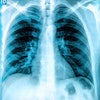WASHINGTON, DC - Speech pathologists frequently identified laryngeal penetration or aspiration that was not described by radiologists viewing the same videofluoroscopic swallowing study (VFSS), according to research presented May 8 at the centennial meeting of the American Roentgen Ray Society.
To determine the frequency and potential causes of discrepant readings, researchers from the Loyola University-Chicago in Maywood, IL, studied 55 consecutive patients ranging in age from five months to 93 years (mean age 64 years) who underwent VFSS at Loyola University Medical Center.
Indications for the VFSS were central nervous system dysfunction (19), generalized debilitated state (15), prolonged intubation (9), suspected aspiration (8), and dysphagia (4). As is the case at many institutions, the VFSS is a multidisciplinary endeavor at Loyola, said Dr. Carl Kalbhen, formerly of Loyola and now of Northwest Radiology Associates of Arlington Heights, IL.
During each examination, a speech pathologist administered barium in various consistencies by mouth, and swallowing was monitored fluoroscopically and videotaped by a radiology resident. Each study was prospectively and independently interpreted by one of six radiologists (from the dubbed videotape along with the radiology resident) and by one of eight different speech pathologists (also from the videotape). Each interpreter identified and described episodes of laryngeal penetration and aspiration.
Examination interpretations completely agreed in 40 patients (73%). The radiologist and speech pathologist disagreed in the assessment of laryngeal penetration alone in five (9%) patients, of aspiration alone in eight (15%), and of both processes in two (4%).
The Loyola researchers concluded that the discrepancies were not random, as each involved a speech pathologist identifying laryngeal penetration or aspiration that was not described by a radiologist. Interobserver agreement was slightly better for assessment of aspiration than for penetration, according to the study team.
The radiologists identified penetration in 40 (73%) cases and aspiration in 20 (36%). The speech pathologists, on the other hand, identified penetration in 47 (85%) cases and aspiration in 30 (55%) of patients.
"There are discrepancies between radiologists and speech pathologists in the interpretation of VFSS, and this pattern was consistent over multiple radiologists and multiple speech pathologists," Kalbhen said.
The reasons for the discrepancies were not addressed in the study, but were likely due to basic differences in training and dogma between the two disciplines, Kalbhen said.
But the differences could also be due to the presence of the speech pathologist during the exam, according to an audience member at Kalbhen's presentation. The radiologist did not have the same benefit of witnessing the study in progress in the Loyola study, a factor that could have resulted in missing diagnostic information, the commentator observed.
"It's not uncommon that I see an episode (of laryngeal penetration and aspiration) live and the videotape does not demonstrate it," she said.
By Erik L. Ridley
AuntMinnie.com staff writer
May 9, 2000
Let AuntMinnie.com know what you think about this story.
Copyright © 2000 AuntMinnie.com


















